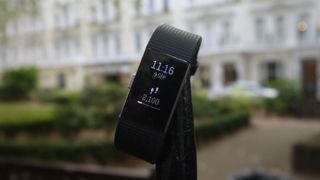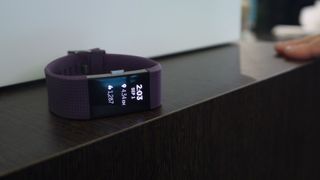Why you can trust TechRadar
Compatibility
- Limited phone notifications don't prove that useful
- Works with a large variety of smartphones
- Easy to set up and connect to your phone
The Fitbit Charge 2 works as a standalone fitness tracker, but you'll need to connect to your phone over Bluetooth to use GPS or receive notifications.
You can get calls, SMS and calendar notifications on your wrist via your phone, but they will be just that – notifications. You won't be able to reply without taking your phone out, as you could on an Android Wear smartwatch via voice commands or by tapping on the screen to send pre-loaded replies.
It's also a shame that Fitbit hasn't seen fit to expand the variety of notifications you can receive on the Fitbit Charge 2. If you buy an Android Wear smartwatch a good number of apps will be able to send notifications to it.
That said, if you're out for a run and feel your phone vibrating in your pocket it's useful to be able to see who's calling before stopping your run – and it's nice to have the peace of mind that you won't miss out on anything.

As long as you have an iPhone 4S or above, an Android phone running Android 4.3 or above, or a Windows 10 device, the Charge 2 will sync with your smartphone.
You can connect to your phone's GPS easily through the Fitbit app – but bear in mind that to be able to use the GPS feature on an Android phone you'll need to be running Android 5 Lollipop or newer.
You can check your device is compatible using the Fitbit device platform and searching for Fitbit Charge 2.
App
- Simple to set up and use
- In-depth details from all the features of your tracker
- Free to download for Android, iOS and Windows 10 Mobile
The Fitbit Charge 2 connects to the Fitbit app on your smartphone, and it's one of the simplest fitness apps to use, and to get used to.
The app talks you through the process of setting up your Charge 2, and everything the app can do is explained in a useful tutorial as well.
Within the app you'll be able to see your fitness stats broken down by days. Initially you'll be shown the number of steps you've managed, your average resting heart rate, and whether you've moved enough each hour.

Other features include the distance you've traveled, estimates of your calories burned, and the number of floors you've walked up. Everything is presented simply and intuitively, and tapping on a section will reveal further stats.
You can, for example, see an hour by hour breakdown of your step count, which can be really useful to highlight the workouts you've been doing each day.
Exercises are in a separate section, and again you'll see a breakdown of what you've done. If you're an active person you might want to turn off Walk, as this will track and record all 15 minute-plus trips; conversely, if you want to include shorter bursts, such as five-minute walks, you can do that in the settings.
Another new addition to Fitbit's app skills is Fitbit Coach, a second app dedicated to more serious training. The app features 100s of workouts, each with its own set of guided video drills to help you shape up with everything from running-focussed sessions to HIIT.
Some of the session are accessible via the main Fitbit app and come free, though you will still need to download the Coach app to access the content. And the majority of the workouts are tucked away behind a premium pay wall.
Access to the premium app will still set you back £5.99 per month for £29.99 ($39.99, about AU$50) for the year.
Battery life
- Should last you over four days
- Difficult to recharge if you want to use sleep tracking
- Recharges in less than two hours
Fitbit claims the Charge 2 will last you up to five days from a single charge. We found we didn't quite hit that mark, but we were using the device pretty intensively.
But if you're not constantly using the fitness-tracking, heart rate and breathing-tracking features you'll be able to get close to five days on a single charge.
On average we found that we got around three and a bit days of use from our fully-charged Charge 2; that's not too bad, as it means you'd only be recharging the device twice a week.
Fitbit has included its propriety charger in the box, but we'd prefer it if we could use a microUSB charger; being dependent on Fitbit's charger meant we couldn't charge the device when we got to work and realized we'd left our charger at home.

Another issue is finding a good time to charge the tracker. The obvious time to charge a wearable or phone is overnight, but if you want to wear the Charge 2 to bed to track your sleep then you won't be able to do that. At least it doesn't take long to charge the device – around two hours.
You'll also be notified when the battery is low, via both the Fitbit app and an email – we found the emails to be a little bothersome, but it's simple matter to disable those alerts.
Thankfully, Fitbit has issued an update that shows battery percentage on the device, so that a soon-to-deplete battery doesn't take you by surprise.
Image Credit: TechRadar
Current page: Compatibility, app and battery life
Prev Page Specs, performance and fitness Next Page Verdict and competitionJames is Managing Editor for Android Police. Previously, he was Senior Phones Editor for TechRadar, and he has covered smartphones and the mobile space for the best part of a decade bringing you news on all the big announcements from top manufacturers making mobile phones and other portable gadgets. James is often testing out and reviewing the latest and greatest mobile phones, smartwatches, tablets, virtual reality headsets, fitness trackers and more. He once fell over.


